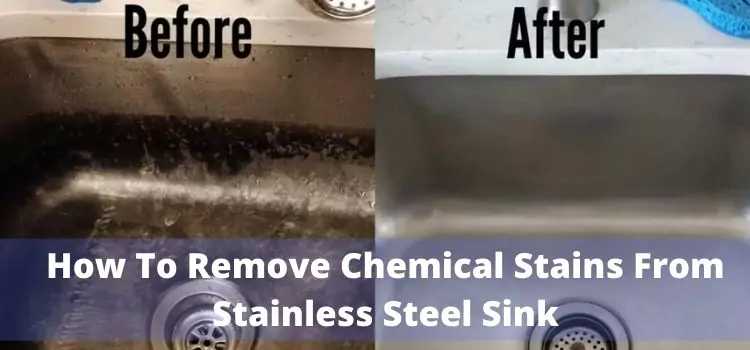· Kitchen Cleaning · 7 min read
How To Remove Chemical Stains From Stainless Steel Sink

Stainless steel sinks are one of the most popular kitchen appliances in homes worldwide. They not only look beautiful and sleek, but they are also very durable and can last for many years.
One of the most common problems that homeowners face is the removal of chemical stains from stainless steel sinks.
These stains can be difficult to remove, and in some cases, they may require professional help.
Are you looking for a way on how to remove chemical stains from stainless sink? If so, fret no more, as you are at the right place. This guide has the perfect solution for you!
With a bit of elbow grease and some common household ingredients, it’s easy to get the job done. Read on to get your stainless steel sink stain-free!
How to Remove Chemical Stains from Stainless Steel Sinks
Stainless steel sink is protected with a surface called chromium oxide.
This protective layer prevents rust and corrosion, but if you use harsh chemicals, this layer will gradually lose its power, and as a result, chances will increase the stainless steel getting stained.
So be careful; don’t just put or use anything to clean it. Especially while you choose the commercial cleaner to clean it, keep in mind this.
However, to remove chemical stains from stainless steel sinks without damaging them or their protective layer, we will use DIY ingredients that are totally safe.
Let’s know the step-by-step removal process of chemical stains from stainless steel sinks.
Equipment You Will Need
Baking soda, dish liquid, lemon juice, bowl, spoon, old toothbrush, nylon brush, sponge, rag, dry microfiber cloth, hand gloves, face mask, goggles.
Step One: Take Immediate Action
Chemical stains on stainless steel sinks are not something good; you should take immediate action to remove them. Because the more time it will stay, the more damage it will cause.
So whenever you notice it, wear your protective gear and jump to follow the next steps and get rid of it.
Step Two: Prepare DIY Solution
As we said, we will use a DIY Cleaning solution, so we need to make the cleaning solution before we proceed with the cleaning process. Grab the ingredients, and let’s start.
Take baking soda ( available in every home), and dish liquid in equal quantity in a bowl. Mix them with the help of a spoon or whatever that can do the job.
Mix until baking soda dissolves and turn into a thick paste. We don’t want a super thick paste, so we need to add two tablespoons of lemon juice to get it in the right texture. You can use distilled vinegar if you don’t have lemon juice.
Step Three: Apply the Cleaning Solution
Now our cleaning solution is all ready to apply, so don’t be late applying it immediately on the chemical stains.
Ensure you have covered the chemical stains completely. Now leave it for 10 minutes to show its magic.
Step Four: Scrub
Once time is up, we have to scrub the chemical stains. Take an old toothbrush or nylon brush and scrub gently.
For better results, you can spray some vinegar and keep scrubbing. Don’t forget to scrub the other areas of the sink. Do it multiple times until the stains are gone.
Step Five: Rinse Away With Warm Water
After getting rid of the chemical stains, you have to escape from the residue stains.
For that, you have to use warm water to rinse away the cleaning solution residue and have to rinse it very well.
Step Six: Dry With Microfiber Cloth
Only rinsing away with warm water isn’t enough to get rid of residue stains.
Use a microfiber cloth to dab the entire sink surface to absorb the excess moisture and then let it dry naturally.
Follow this step after every time you use the sink. This will help keep your sink shiny and damage-free for a long time.
How to Remove Stubborn Chemical Stains from Stainless Steel Sink
When the chemical stain is stubborn and doesn’t take the name of going away after following the steps we shared above, it’s time to use degreasers like vinegar or ammonia.
Vinegar and ammonia both are effective degreasers and can remove chemical stains.
Let’s know how to use vinegar or ammonia to remove stubborn chemical stains from stainless steel sinks.
Method One: White Vinegar/Apple Cider Vinegar
This process is simple; all you need to do is-
- Grab a paper towel, white vinegar, or apple cider vinegar, whatever you have, and a dry microfiber cloth.
- Fill the spray bottle with vinegar spray directly on the chemical-stained area.
- Leave it for a few minutes (10-15 minutes)
- Rub the chemical-stained area with a paper towel.
- Wipe away the entire sink surface with a microfiber paper towel
Method Two: Ammonia And Warm Water
Ammonia is a degreaser like vinegar, but the cleaning process is not the same.
- Make a paste of ammonia and warm water in equal quantity
- Apply the paste on the chemical stained area, and wait for 10-15 minutes
- Scrub with a sponge if needed, spray some white vinegar and scrub well with a nylon brush.
- Spread the solution all over the sink and scrub. Scrape the residue.
- Wipe away with a dampened microfiber towel to clean the residue perfectly.
Know More on Be A Cleaner
How To Clean Olive Oil Spill In The Kitchen
Easily Remove Rust From Knives With Baking Soda
Frequently Asked Question
How Do You Remove Acid Stains from A Stainless Steel Sink?
To remove acid stains from a stainless steel sink, you will need a stainless steel cleaner.
Be sure to test the cleaner on a small area first to ensure it does not damage the sink.
Then, pour the cleaner into a spray bottle and mist the stain with the spray.
Allow the cleaner to work its magic for a few minutes, and then wipe the stain clean with a cloth or paper towel. Repeat as necessary.
How Do You Fix a Bleach Stain in A Stainless Steel Sink?
Make a baking soda or ammonia paste and warm water, and apply it to the stain.
Let the paste soak in for a few minutes, then scrub it with a stainless steel scrubber. Rinse the sink with clean water and dry it off.
What Happens when You Use Muriatic Acid on Stainless Steel?
Muriatic acid is an acid that is used to clean surfaces such as stainless steel. When muriatic acid is used on stainless steel, it attacks the metal and causes it to corrode.
Corrosion can occur in various places, including the surface of the tank, the pipe, and the fittings. The result is a decrease in the system’s efficiency and possibly an increase in maintenance costs.
Does Vinegar Damage Stainless Steel?
No, vinegar doesn’t damage stainless steel. Vinegar is a natural acid, and while it can corrode stainless steel, it is not as damaging as some other chemicals that are used in the kitchen. In fact, vinegar is effective in cleaning stainless steel!
Will Bleach Ruin a Stainless Steel Sink?
Bleach can damage stainless steel sinks if it is used excessively or if it is not properly diluted.
Exposure to bleach can cause corrosion and eventual rusting of the sink. It may be challenging to repair or replace the sink if this happens.
In addition, bleach can also cause a yellowing of the metal, which may be difficult to remove.
Conclusion
Stainless steel sinks are beautiful, sleek, and practical, but they can also be stained with various chemical residues.
While removing chemical stains from stainless steel sinks can be a daunting task, you can treat them in various ways to remove stubborn chemical stains.
But keep in mind, this isn’t an easy process. It requires a bit of patience and skill. However, with a few tries, you will be able to get rid of chemical stains from your stainless steel sink.
We have shared a few methods on how to remove chemical residues from stainless steel sinks using simple and effective ingredients.
By following our steps, you will be able to remove chemical stains and keep your stainless steel sink looking new for years to come!




